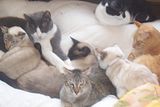October 10, 2004
http://www.nytimes.com/2004/10/10/ny...ty/10cats.html
Wild Things
The shadow cats come out at night.
In the daytime, New York's homeless cats are too frightened to emerge from
behind the grated openings where they lurk, or from the abandoned buildings
and overgrown lots where they live. They listen as trucks and buses roll
noisily by, and watch in stealthy silence as pedestrians go about their
chores.
True, there are hints. Somewhere in the city, a child may see a flash of
black, white or orange that disappears in seconds. Tiny teeth marks will
appear on the remains of a fried-chicken lunch that has been tossed into a
corner. Birds will steer clear of one particular bush, sensing that danger
lies beneath its leaves.
But it is the night that is the real domain of the shadow cats, the time they
come alive. Atop a box in a cemetery in southeast Queens, a snaggletoothed
black-and-white veteran named Oreo guards his kingdom. On Roosevelt Island,
Princess YinYang leaps into the air, a small blur of black and white as she
chases fireflies across the grass. On Grand Street on the Lower East Side,
small coal-black sisters named Topsy and Beebee trot out behind their mother
from an abandoned building to forage for food.
Commonly known as ferals - their "names'' come courtesy of observant
passers-by - the shadow cats have become an increasingly visible part of the
urban landscape. One reason is that greater development and density leads to
an increase in abandoned pets and more places for them to hide. Another is
that public awareness of the problem has increased exponentially.
"Our rough estimate would be somewhere between 100,000 and 200,000 feral cats
in the five boroughs," said Bryan Kortis, executive director of Neighborhood
Cats, a five-year-old group that seeks to control the city's feral population
through T.N.R. (trap-neuter-return), a program in which animals are caught,
neutered and placed in homes or returned to their habitat.
Today, according to Mr. Kortis, the typical abandoned cat is eight months to a
year old and unneutered.
"People get these animals when they're kittens,'' he said. "Then they grow up,
and they're not these cute fluffy things. They spray against the wall. They
howl at night. Instead of just getting them neutered, people abandon them."
The cats have litters, and the litters have litters.
In the last decade, an alphabet soup of rescue groups has sprung up around the
city. They are typically staffed by passionate animal lovers, many of whom
will attend the Neighborhood Cats' National Feral Cat Summit to be held
Saturday (National Feral Cat Day) at the SLC Conference Center on Seventh
Avenue near 29th Street. (Cats of a much more pampered variety can be seen
today at the Cat Fanciers' Association show at Madison Square Garden.)
Rescue workers are almost pathologically reluctant to identify neighborhoods
where ferals congregate, fearful that doing so will only encourage further
dumping. At the same time, they engage in intense debates over subjects like
no-kill shelters, sterilization, euthanasia and managed colonies, an approach
in which cats living together are neutered, returned to their habitat and
supervised by human caretakers until they die out naturally.
Cats Here, Cats There . . .
Until the Depression, life for New York's feral cats was probably like that of
strays in Mediterranean countries today. They roamed and procreated, living
off rats, garbage and the kindness of strangers. "The difference is that there
is a warm climate there," said Mike Phillips, a choreographer-director and
veterinarian technician who founded the Urban Cat League two years ago. "The
harsh winters here cut down on reproduction, because the animals couldn't
survive.''
Humans also helped control the numbers. Through the 19th century, strays were
rounded up in large numbers, and until late in the 19th century, when the
Women's S.P.C.A. in Philadelphia developed the first humane euthanasia gas
chamber for animals, unclaimed dogs and cats were unceremoniously clubbed to
death or crowded into cages and drowned.
But the rescue scene has changed considerably since the 1950's, when the
glamorous burlesque queen Gypsy Rose Lee donned sneakers and climbed over
rubble to bring food and water to homeless cats. In 1957 Judith Scofield
founded the pioneering Save a Cat League in Manhattan. Now the city is home to
more than 60 incorporated animal shelters and rescue groups, according to Mr.
Kortis of Neighborhood Cats, and an equal number of unofficial ones.
In this respect, New York is one of the most advanced cities in the nation,
and its shelter and rescue movement has become formidably organized under the
umbrella of the Mayor's Alliance for New York City's Animals. But many of the
rescuers belong to ad hoc groups of neighbors, whose war stories are told by
Janet Jensen in her 2002 book "Shadow Cats: Tales From New York City's Animal
Underground.''
New York rescuers come from a wide variety of professions and income levels.
What starts with the seductively kind act of saving a starving storefront cat
or a playful backyard stray quickly becomes a full-time occupation. There is
never only one cat. But frantic calls to rescue and shelter groups reveal that
most are too overwhelmed to help. So unofficial rescuers join the ranks of
official rescuers, and they fight on many fronts.
Nancy Fahnestock, a middle school teacher who is the treasurer of the CSM
Stray Foundation, based in Kew Gardens, Queens, answers questions sent to the
group's Web site, an activity that she said made her feel "like the Dear Abby
of the feral-cat cyber world."
CSM's chief feeder is Carole Milker, a legal secretary who is the foundation's
president and whose initials gave the group its name. Meals are served at the
same time seven mornings a week at the cemetery in southeast Queens, and are
greeted by a mob scene worthy of a Cecil B. DeMille spectacular. Cats race
like film extras from every direction as Ms. Fahnestock's car pulls in. Ms.
Milker calls out to each cat by name as she steps from the car, puts on latex
gloves to protect her own cats from disease, and doles out wet and dry food,
along with vitamin-laced water.
Rob Maloney, a former firefighter, discovered two years ago that a managed
colony was the best way to curb the growing feral population in the garden of
the hospital in Flatbush, Brooklyn, where he worked as a security chief.
Everyone pitched in, from hospital engineers who built Mylar-lined shelters
for the cats to elderly patients who painted the structures. Cecilia Fortune,
a hospital office worker, dispenses vitamin C, occasional treats of sardines
and, in winter, cod liver oil. Food is purchased in bulk and on sale, and the
hospital provides peroxide and swabs to treat the cats' cuts.
. . . Cats and Kittens Everywhere
Feral cats know no geography.
On West 136th Street between Lenox Avenue and Adam Clayton Powell Jr.
Boulevard in Central Harlem, the gentrification that has produced gleaming
renovated brownstones has also spawned a generation of ferals so fearless that
they strut about as brazenly as pedestrians, even in daytime.
With the whir of construction on abandoned buildings, cats are being displaced
throughout the area and being forced to find homes wherever they can, much to
the chagrin of homeowners. A few weeks ago, one resident opened her window to
find a kitten asleep in her flower box, an adorable tiger who promptly lunged
toward the screen and started hissing like a snake. All summer, a homeless cat
slept outside on one resident's air-conditioner, gazing longingly into a
bedroom where two pampered house cats snoozed lazily on the comforter.
Ferals have formed a little outlaw civilization in Riverside Park, just south
of the Soldiers' and Sailors' Monument. Every morning before dawn, while most
humans in the neighborhood are still asleep, the dozen animals that comprise
this pack emerge from the park and line up on the stone wall along Riverside
Drive in anticipation of the arrival of their prime benefactor, a local
doorman who feeds them wet food before his morning shift.
Things are especially bad in Howard Beach, Queens. The area, which sits in the
shadow of the sleek new AirTrain terminal at John F. Kennedy Airport and is
crisscrossed by numerous small inlets from Jamaica Bay, has been host to
generations of feral cats, who roam its streets and graze in its yards. In one
section, four cats multiplied to an estimated 30 in a matter of months. The
thick ridges of eight-foot-tall reeds bordering the swamps are ideal hiding
spots.
Much of Howard Beach is not particularly urban. Swans and ducks swim in its
ponds, many families dock boats from their back porches, and at least one
house has a flock of chickens in its front yard. But the neighborhood is also
home to neatly maintained houses that sit on small, winding streets and are
fronted by lawns enclosed in fences painted a blinding white. And it is the
residents of these houses who are complaining.
By last May, ferals seemed to control the streets. One man could no longer
park in his driveway, thanks to a family of cats that held court under one of
his cars and refused to budge. The pungent odor of urine from unneutered males
and the howls of females in heat permeated the neighborhood's days and nights.
It was then that Robert Schmidt and his fiancée, Lisa Ranallo, decided to take
action. Mr. Schmidt, who works as a supervisor at the A.S.P.C.A.'s Bergh
Memorial Animal Hospital on the Upper East Side, and Ms. Ranallo, who used to
work for the A.S.P.C.A., lived near 102nd Street and 160th Avenue, just a few
doors from the neighborhood's most recent feral cat hangout.
Over two nights, the couple set about catching the animals in humane traps
provided by the A.S.P.C.A. After about 30 cats were caught, an A.S.P.C.A. van
arrived in which each of the animals was spayed or neutered. With the help of
the local councilman, Joseph P. Addabbo Jr., the cats were billeted overnight
at the nearby South Queens Democratic Club. ("While they were there,'' Mr.
Addabbo said, "we registered them as Democrats.")
The fixed cats were then released, only to be joined by new arrivals, some of
which have taken over an abandoned house near a bridge. A stroll past Riley's
Yacht Club on Russell Street confirms the cats' presence. Perched on the stern
of a grounded motorboat, a lone, uncollared black tom stared intently at
passers-by.
Some feed off garbage spilling from two battered street bins. Others have been
welcomed by kindly householders, who set out dishes of food and water in their
gardens. Next to one house is an abandoned shack, its padlocked front door
open just enough to admit cats seeking shelter in the cold or rain. Cats of
all sizes, colors and ages sit curled in one front yard, some boldly ensconced
on stair railings and windowsills.
A few look healthy. Others have swollen bellies from worm infestation, or
discharge from their eyes that signals upper respiratory infections, highly
contagious to cats though not to humans, that will probably prove fatal.
Carcasses of dead cats have been found in a nearby parking lot and sometimes
in front yards.
But it is another telltale remnant that bothered one resident. "I have two
young children, 5 and 6," said a slender woman with blond hair who identified
herself only as Joanne. "I can't let them play in the street. But 9 times out
of 10, they can't play in the yard." This is because the cats try to bury
their feces there. "It's messy and yucky,'' she added. "I can't get it all.
The children roll in it. We like to barbecue, but I have to tell people,
'Don't walk there.' '' She considered putting out a litter box, but decided
that it would make matters worse.
"The funny thing is,'' she added, "I love animals. I just don't want them to
poop on my lawn. This wasn't a problem when we moved here in 1998, but since
then they have been multiplying like crazy. I've about had it."
The Beauty in 'Smushed' Faces
Some feral cat stories have a happy ending.
For many years, Cindy Workman, a 42-year-old mixed-media artist who lives in
the garment district, owned a black and white house cat named Spike. When
Spike died last year, at age 13, Ms. Workman approached her friend Cathe
Neukum, a documentary filmmaker who works with the Urban Cat League, seeking
advice about finding an adoptable feral. Ms. Neukum took her to the outdoor
sanctuary for hard-core ferals near the Lincoln Tunnel that is run by the
League, which has placed cats in settings as unlikely as the offices of the
Roundabout Theater.
Not all of the cats began as adoption material. For a time, volunteers had to
approach a vicious cat they called Dick with bulletproof gloves, though now,
after liberal doses of mackerel and laxatives, he is extremely friendly. For
Ms. Workman, the League selected a cat more likely to be socialized.
Then she saw a stunted creature with an overbite, a tiny cat who was four
years old but looked like six months, and found him too delicious to leave
behind. She returned to her loft with two black cats, the large and
comparatively confident Roman and also Bobo, her "little cartoon cat."
"Their faces are a little smushed," Ms. Workman admitted. "I think they're
beautiful, but obviously they're at the bottom of the beauty pool. They look
like bats, or those things that hang upside down in Australia."
At first the cats hid. Then they stopped hiding, but fled when strangers
approached. They urinated in pots of plant soil instead of the litter box.
When Ms. Workman reprimanded them, they urinated in other places. At first,
they scratched her furniture, their claws getting stuck in her leather sofa
until she covered their favorite parts with foil.
Ms. Workman was patient, and free with bribes of food. Because she works at
home, she could play with them regularly during the day.
Roman and Bobo still do not let her pick them up, but they enjoy being petted,
and they no longer hide. Although sudden big gestures frighten them and they
run when they hear loud noises, they don't run far in the apartment and they
come back.
Ms. Workman recently scolded Roman for using plant dirt as litter, but, she
said, "instead of payback, he was fine about being reprimanded.''
"These guys,'' she added with the satisfaction of a proud parent, "they're
almost 100 percent.''








 Reply With Quote
Reply With Quote





Bookmarks